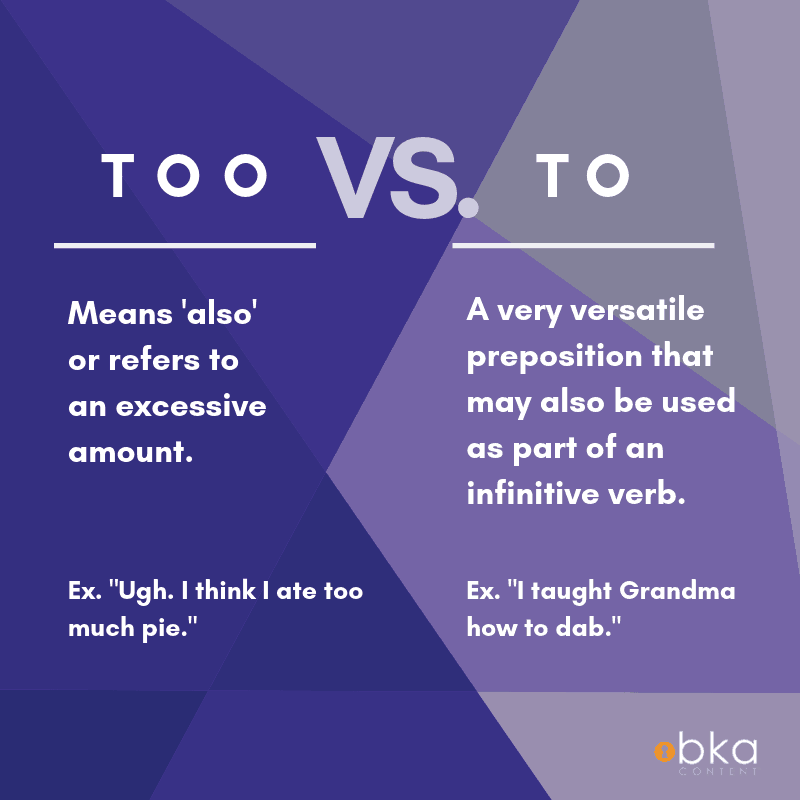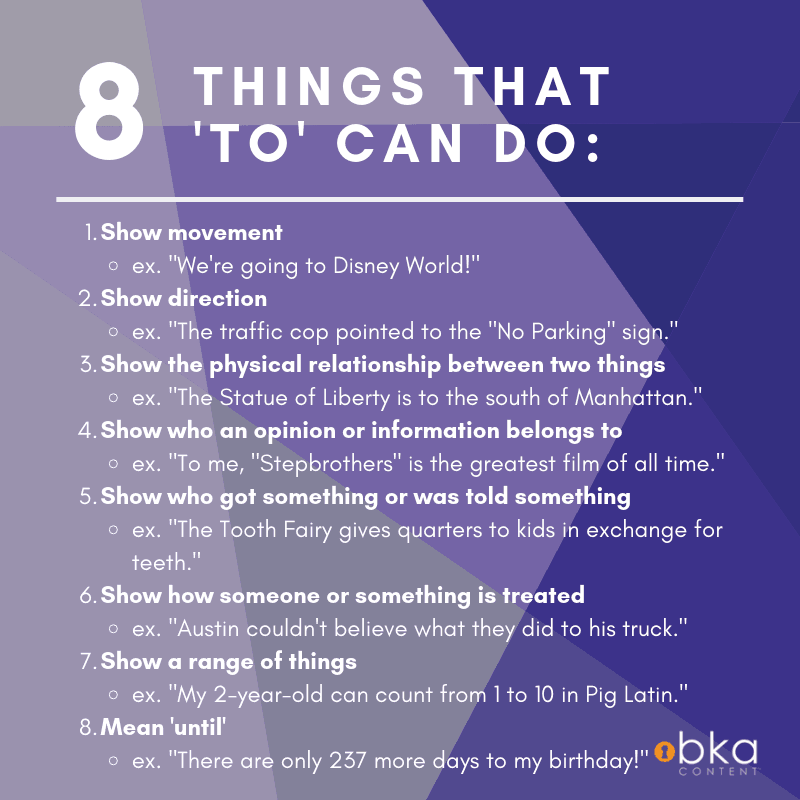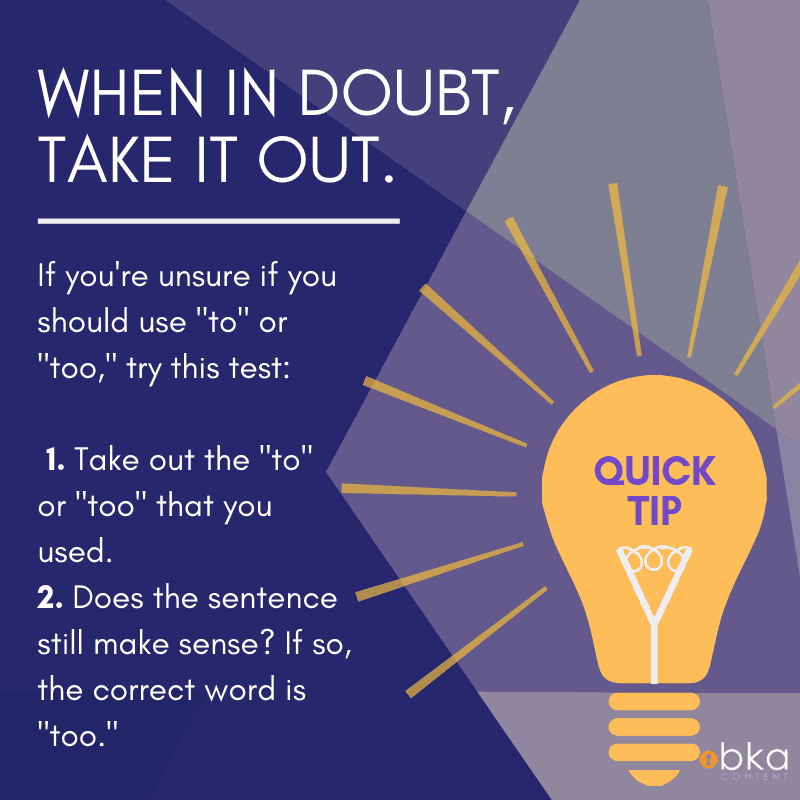
Commonly Confused Words: To vs. Too

Grammar would be so much easier if Prince invented it. For starters, you’d never have to worry about whether you should use to or too in a sentence. If Prince were in charge, the whole to vs. too issue would be moot because you’d just use the number 2 — for everything. Picture it:
- Nothing compares 2 U.
- Can U hand this pudding 2 Grandpa, please?
- We R going 4 fro-yo. Do U want 2 go 2?
Sadly, Prince didn’t invent grammar. He just revolutionized pop music instead. That means you still need to know when to use to vs. too. Put on your raspberry beret, grab your writing supplies, and let’s go crazy.

Via GIPHY
How Do You Know When To Use To vs. Too?
Understanding the roles that to and too play can help you decide which one to use and when. There’s a quick and relatively painless test that you can perform, but let’s not get too ahead of ourselves.

1. Too means also or refers to an excessive amount.
Too is an adverb. It has two main roles. The first is as a synonym for words such as also, as well, or in addition. Take a look at these examples of using too:
- I’d like to order the 14-pound burrito too.
- Trent has seen every episode of “Beverly Hills, 90210” too.
- If you want to go too, I can ask Millie if she has any more room in her car.
- I, too, love the smell of napalm in the morning.
You may have noticed that sometimes there’s a comma before too and sometimes there isn’t. The general rule is that you only have to add a comma before too if you want to create emphasis or intentionally interrupt or slow down the flow of the sentence, as in that last too example above. When you’re adding too to the end of a sentence, on the other hand, it rarely requires a comma.
Now that that’s settled, let’s talk about the other job that too can do. You can use too to indicate excess or an overload, such as in these examples:
- Tina would love to go to Comic Con, but the tickets are too expensive.
- Connor can’t watch horror movies because he scares too easily.
- Too many young adult books are set in dystopian futures.
- Ugh. I think I ate too much pie.
Too much vs. to much is one of the most common sources of confusion for writers. Unless you know a person or a place named Much, it’s highly unlikely that you’ll ever need to write to much. One of the exceptions of using too much vs. to much is when you’re talking broadly about a group – but the use case is more rare. For example:
- To much of the world, I’m known as a celebrity.
Aside from that, defaulting to too much is probably the safest bet.
That brings us to our next point: What does to mean?
2. To means, well, a lot of things.
I’m not being glib here. Ask any seasoned freelance writer and he or she will tell you: To is like the Swiss army knife of prepositions. The list of things that to can do is so long and varied that, if you’re trying to decide which word to use, it’s way easier to ask yourself, “Do I mean also? Am I talking about excess?” If the answer to either of those two questions is yes, then you need too. If the answer is no, then you likely need to.

Examples of To in Preposition Mode
Here are just a few things that to can do when it’s in preposition mode:
|
Show movement |
We’re going to Disney World! Danny beat Craig to the last slice of pizza. |
|
Show direction |
The traffic cop pointed to the “No Parking” sign and rolled her eyes. Madame Minerva looked to her crystal ball for guidance. |
|
Show the physical relationship between two things |
The Statue of Liberty is to the south of Manhattan. The men’s room is to the left of the ice cream sundae bar. |
|
Show who an opinion or information belongs to |
To me, “Stepbrothers” is the single greatest film of all time. To my knowledge, Kendall has never once picked up the tab for brunch. |
|
Show who got something or was told something |
The Tooth Fairy gives quarters to kids in exchange for teeth. Elaine gave a presentation about worms to her science class. |
|
Show how someone or something is treated |
Austin couldn’t believe what they did to his truck. Thanks for being civil to my obnoxious Uncle Ray. |
|
Show a range of things |
My 2-year-old can count from 1 to 10 in Pig Latin. In his seven years of college, Parker majored in everything from microbiology to dance. |
|
Mean until |
Kim had a perm from roughly June 1988 to December 1992. There are only 237 more days to my birthday! |
That’s not even a complete list of what to can do as a preposition, but you get the gist. To can also be used as part of an infinitive verb. Check it out:
- Rory’s dream is to play bass for Limp Bizkit.
Here, to is part of the verb phrase to play.
- I taught Grandma how to dab.
In this example, the verb phrase is to dab. Get it, Granny.
- Nina will do her Jerry Seinfeld impression if you ask her to.
In this instance, to acts as a stand-in for the full, implied verb phrase to do it, as in Nina will do her best Seinfeld if you ask her to do it.
Test Your Sentence by Removing To and Too

If you’re unsure about your word choice, one way to test it is to take out the to or too that you used. If the sentence still makes sense without it, then the word you’re looking for is likely too. Take a look at these examples removing too to see what I mean:
- Chad can juggle chainsaws too.
- Chad can juggle chainsaws.
- I, too, would like a margarita with no salt.
- I would like a margarita with no salt.
Since removing too from both of these examples doesn’t turn them into caveman gibberish, we can be pretty confident that too is the right word. If you remove to from a sentence, on the other hand, it usually makes the sentence sound weird:
- I’d like to see your manager, please.
- I’d like see your manager, please.
- Becca brought coleslaw to the cookout.
- Becca brought coleslaw the cookout.
In both of these sentences, taking out to makes the sentences sound strange. That’s the trick: If you take out the to/too and the sentence still sounds odd, the right word is to. If the sentence still sounds good, the correct word is too. This is a great rule to follow when deciding between to vs. too.
To vs. Too Question Solved!
Understanding what to and too can do for you in a sentence goes a long way toward mastering to vs. too. Do you have any tips for telling to from too? Have you ever dreamed of moving to Minneapolis, growing a tiny goatee, and changing your name to a symbol? (Just me then?) Sound off in the comments below!
- Contractions Grammar 101: A Guide With Examples - December 13, 2023
- What Is an Antonym? Opposites 3 Ways - December 9, 2023
- Analogy Definition With Detailed Examples - December 8, 2023

